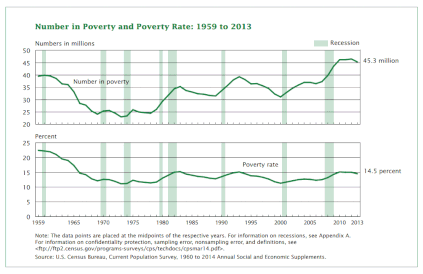
Poverty and health are intertwined in the United States.[1] As of 2019, 10.5% of Americans were considered in poverty, according to the U.S. Government's official poverty measure. People who are beneath and at the poverty line have different health risks than citizens above it, as well as different health outcomes. The impoverished population grapples with a plethora of challenges in physical health, mental health, and access to healthcare. These challenges are often due to the population's geographic location and negative environmental effects. Examining the divergences in health between the impoverished and their non-impoverished counterparts provides insight into the living conditions of those who live in poverty.
A 2023 study published in The Journal of the American Medical Association found that cumulative poverty of 10+ years is the fourth leading risk factor for mortality in the United States, associated with almost 300,000 deaths per year. A single year of poverty was associated with 183,000 deaths in 2019, making it the seventh leading risk factor for mortality that year.[2][3][4][5][6]
- ^ Patrick, Donald L.; Stein, Jane; Porta, Miquel; Porter, Carol Q.; Ricketts, Thomas C. (1988). "Poverty, Health Services, and Health Status in Rural America". The Milbank Quarterly. 66 (1): 105–136. doi:10.2307/3349987. JSTOR 3349987. PMID 3262817.
- ^ Brady, David; Kohler, Ulrich; Zheng, Hui (2023). "Novel Estimates of Mortality Associated With Poverty in the US". The Journal of the American Medical Association. 183 (6): 504–628. doi:10.1001/jamainternmed.2023.0276. PMC 10111231. PMID 37067817.
- ^ Danelski, David (April 17, 2023). "Poverty is the 4th greatest cause of U.S. deaths". UC Riverside News. Retrieved June 23, 2023.
- ^ Barber, William; Gonsalves, Gregg (June 22, 2023). "The fourth leading cause of death in the US? Cumulative poverty". The Guardian. Retrieved June 27, 2023.
- ^ Hughes, Clyde (April 17, 2023). "Poverty is fourth-largest cause of U.S. deaths, researchers say". United Press International. Retrieved July 2, 2023.
- ^ Jarow, Oshan (July 14, 2023). "Poverty is a major public health crisis. Let's treat it like one". Vox. Retrieved August 24, 2023.
A single year of poverty, defined relatively in the study as having less than 50 percent of the US median household income, is associated with 183,000 American deaths per year. Being in 'cumulative poverty,' or 10 years or more of uninterrupted poverty, is associated with 295,000 annual deaths.